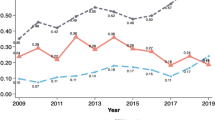Abstract
The purpose of this paper is to develop a welfare-maximizing location model for a regulated firm and then to compare it with a profit-maximizing model as set forth by previous location theorists. It will be shown that two otherwise identical firms harboring different objectives will have different patterns of industrial location.
Similar content being viewed by others
References
Beckmann, M. J., “Spatial Price Policies Revisited,”Bell Journal of Economics 7 (1976), 619–30.
Bradfield, M., “A Note on Location and Theory of Production,”Journal of Regional Science 11 (1971), 263–66.
Denike, K. G. and J. B. Parr, “Production in Space, Spatial Competition and the Restricted Entry,”Journal of Regional Science, 10 (1970), 49–63.
Emerson, D. T., “Optimum Firm Location and the Theory of Production,”Journal of Regional Science 13 (1973), 335–45.
Eswaran, M., Y. Kanemoto and D. Ryan, “A Dual Approach to the Locational Decision of the Firm,”Journal of Regional Science 21 (1981), 469–90.
Holahan, W. L., “The Welfare Effects of Spatial Price Discrimination,”American Economic Review 65 (1975), 498–503.
Holahan, W. L., “Spatial Monopolistic Competition versus Spatial Monopoly,”Journal of Economic Theory 18 (1978), 156–70.
Hsu Song-ken and Chao-cheng Mai, “Production Location and Random Input Price,”Regional Science and Urban Economics 14 (1984), 45–62.
Khalili, A., V. K. Mathur and D. Bodenhorn, “Location and Theory of Production: A Generalization,”Journal of Economic Theory 9 (1974), 467–75.
Launhardt, W.,Mathematische Begründung der Volkswirtschaftslehre, Leipzig: B. G. Teubner, 1885.
Mai, Chao-cheng, “Optimum Location and the Theory of the Firm Under Demand Uncertainty,”Regional Science and Urban Economics 11 (1981), 549–57.
Mai, Chao-cheng, “Location and the Theory of the Imperfectly Competitive Firm Under Demand Uncertainty,”Southern Economic Journal 50 (1984), 1160–70.
Martinich, J. S. and Arthur P. Hurter, Jr., “Price Uncertainty and the Optimal Production-Location Decision,”Regional Science and Urban Economies 12 (1982), 509–28.
Mathur, V. K., “Some Unresolved Issues in the Location Theory of the Firms,”Journal of Urban Economics 5 (1979), 299–318.
Mathur, V. K., “Location Theory of the Firm Under Price Uncertainty,”Regional Science and Urban Economics 50 (1984), 411–428.
Miller, S. M. and D. M. Jensen, “Location and the Theory of Production: A Review, Summary and Critique of Recent Contributions,”Regional Science and Urban Economics 8 (1978), 117–28.
Moses, L. N., “Locaiton and the Theory of Production,”Quarterly Journal of Economics 72 (1958), 259–72.
Norman, G., “Spatial Competition and Spatial Price Discrimination,”Review of Economic Studies 48 (1981), 97–111.
Sakashita, N., “Production Function, Demand Function and Location Theory of the Firm,”Papers of Regional Science Association 20 (1967), 109–22.
Sakashita, N., “The Location Theory of Firm Revisited-Impacts of Rising Energy Prices,”Regional Science and Urban Economics 10 (1980), 423–28.
Stern, N., “The Optimal Size of Market Areas,”Journal of Economic Theory, 4 (1973), 154–173.
Weber, A.,Theory of the Location of Industries, Translated by C. J. Friedrich, Chicago, IL: University of Chicago, 1929.
Woodward, R. S., “The Iso-Outlay Function and Variable Transport Costs,”Journal of Regional Science 13 (1973), 349–55.
Author information
Authors and Affiliations
Additional information
The authors would like to thank Professors Curtis Eaton and Stuart Mestelman for useful comments and suggestions.
Rights and permissions
About this article
Cite this article
Hwang, H., Mai, Cc. Welfare-maximizing location versus profit-maximizing location. Ann Reg Sci 20, 54–64 (1986). https://doi.org/10.1007/BF01283623
Received:
Revised:
Issue Date:
DOI: https://doi.org/10.1007/BF01283623




